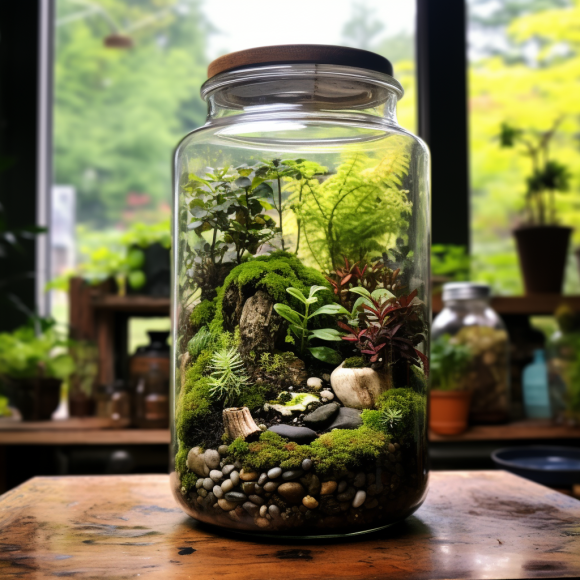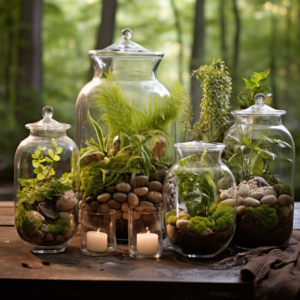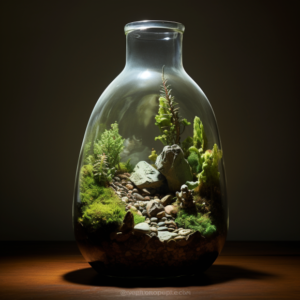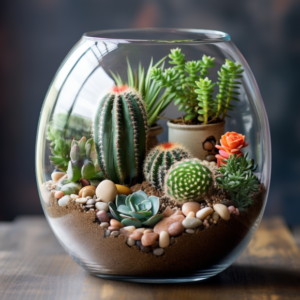While terrariums can be relatively low-maintenance, they may occasionally encounter common issues that require attention. By promptly identifying and addressing these problems, you can help ensure the health and longevity of your terrarium. Here are some common terrarium problems and their solutions:
1. Excessive Moisture or Condensation:
Issue: Excessive moisture or persistent condensation on the terrarium walls can indicate high humidity levels, potentially leading to fungal growth or root rot.
Solution:
- Check the ventilation: Ensure that your closed terrarium has proper airflow by partially opening the lid or removing it for a short period to allow excess moisture to escape.
- Adjust watering: Reduce the frequency and amount of watering to avoid over-saturating the soil. Let the soil dry out slightly between watering sessions.
- Remove excess moisture: Wipe down the walls and lid of the terrarium with a clean cloth or paper towel to remove excess moisture and condensation.
2. Mold or Fungal Growth:
Issue: The presence of mold or fungal growth can be a sign of excessive moisture, poor ventilation, or decaying organic matter in the terrarium.
Solution:
- Improve airflow: Increase the ventilation by partially opening the lid or removing it for a short period to allow fresh air to circulate.
- Remove affected materials: If you spot mold or fungi on plants or decorations, carefully remove and discard them to prevent further spreading. Ensure you sanitize any tools used to avoid cross-contamination.
- Adjust watering: Ensure you’re not overwatering the terrarium. Allow the soil to dry out between watering sessions to discourage fungal growth.
- Maintain cleanliness: Regularly clean the terrarium by removing dead leaves, decaying plant matter, or other organic debris that could contribute to mold growth.
3. Pest Infestation:
Issue: Insects or pests can occasionally find their way into your terrarium, potentially damaging the plants or causing an imbalance in the ecosystem.
Solution:
- Identify the pest: Identify the specific pest infesting your terrarium to determine the most appropriate course of action.
- Remove the pests: Physically remove the pests using tweezers or by gently shaking the affected plants over a sink or outside. Be careful not to damage the plants.
- Natural remedies: Depending on the severity of the infestation, you may consider introducing natural predators or using organic pest control methods to manage the problem.
- Quarantine affected plants: If the infestation persists, quarantine the affected plants to prevent the spread of pests to other parts of the terrarium.
4. Yellowing or Wilting Plants:
Issue: Yellowing or wilting plants may indicate issues such as overwatering, underwatering, nutrient deficiencies, or inadequate lighting.
Solution:
- Adjust watering: Ensure you’re providing the appropriate amount of water for your specific plants. Follow individual plant care guidelines and adjust watering frequency as needed.
- Assess lighting: Evaluate the lighting conditions in your terrarium. Some plants may require more or less light than they are currently receiving. Adjust the placement of the terrarium to provide optimal lighting conditions.
- Nutrient supplementation: Consider adding a balanced fertilizer specifically formulated for terrarium plants to provide essential nutrients that may be lacking.
- Prune and remove affected leaves: If certain leaves are yellowing or wilting, prune them to redirect the plant’s energy to healthier parts.
5. Overgrowth or Crowding:
Issue: Over time, some plants may outgrow their space or crowd out others, leading to an unbalanced terrarium ecosystem.
Solution:
- Prune and trim: Regularly trim or prune plants to maintain a desirable size and shape. Remove excess growth to create more space and allow for better airflow.
- Relocate or propagate: If a plant becomes too large for the terrarium, consider relocating it to a larger container or propagating it to create new plants that fit within the space.
Remember to regularly monitor your terrarium for signs of problems and address them promptly to prevent further complications. Each terrarium is unique, so it’s important to adapt the solutions to suit your specific situation and the needs of your plants.
With proper care and attention, you can overcome common terrarium problems and enjoy a thriving and beautiful miniature ecosystem in your home or office.



